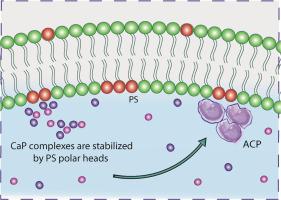Journal of Structural Biology ( IF 3.0 ) Pub Date : 2020-08-26 , DOI: 10.1016/j.jsb.2020.107607 Marcos A E Cruz 1 , Claudio R Ferreira 1 , Camila B Tovani 1 , Flávia A de Oliveira 2 , Maytê Bolean 1 , Luciano Caseli 3 , Saida Mebarek 4 , José Luis Millán 2 , Rene Buchet 4 , Massimo Bottini 5 , Pietro Ciancaglini 1 , Ana Paula Ramos 1

|
Bone biomineralization is an exquisite process by which a hierarchically organized mineral matrix is formed. Growing evidence has uncovered the involvement of one class of extracellular vesicles, named matrix vesicles (MVs), in the formation and delivery of the first mineral nuclei to direct collagen mineralization. MVs are released by mineralization-competent cells equipped with a specific biochemical machinery to initiate mineral formation. However, little is known about the mechanisms by which MVs can trigger this process. Here, we present a combination of in situ investigations and ex vivo analysis of MVs extracted from growing-femurs of chicken embryos to investigate the role played by phosphatidylserine (PS) in the formation of mineral nuclei. By using self-assembled Langmuir monolayers, we reconstructed the nucleation core - a PS-enriched motif thought to trigger mineral formation in the lumen of MVs. In situ infrared spectroscopy of Langmuir monolayers and ex situ analysis by transmission electron microscopy evidenced that mineralization was achieved in supersaturated solutions only when PS was present. PS nucleated amorphous calcium phosphate that converted into biomimetic apatite. By using monolayers containing lipids extracted from native MVs, mineral formation was also evidenced in a manner that resembles the artificial PS-enriched monolayers. PS-enrichment in lipid monolayers creates nanodomains for local increase of supersaturation, leading to the nucleation of ACP at the interface through a multistep process. We posited that PS-mediated nucleation could be a predominant mechanism to produce the very first mineral nuclei during MV-driven bone/cartilage biomineralization.
中文翻译:

磷脂酰丝氨酸控制脂质单层上的磷酸钙成核和生长:对基质囊泡驱动的生物矿化的物理化学理解。
骨生物矿化是一个精细的过程,通过它形成分层组织的矿物基质。越来越多的证据揭示了一类称为基质囊泡 (MVs) 的细胞外囊泡参与第一个矿物核的形成和传递以直接胶原矿化。MV 由具有特定生化机制的矿化感受态细胞释放,以启动矿物质形成。然而,人们对 MV 触发这一过程的机制知之甚少。在这里,我们提出了原位调查和离体研究的结合分析从鸡胚胎生长股骨中提取的 MV,以研究磷脂酰丝氨酸 (PS) 在矿物核形成中的作用。通过使用自组装的朗缪尔单层,我们重建了成核核心 - 一种富含 PS 的基序,被认为会触发 MV 腔中的矿物质形成。Langmuir 单层和非原位的原位红外光谱透射电子显微镜分析表明,仅当存在 PS 时,才能在过饱和溶液中实现矿化。PS成核无定形磷酸钙,转化为仿生磷灰石。通过使用含有从天然 MV 中提取的脂质的单层,矿物质的形成也以类似于人工富含 PS 的单层的方式得到证实。脂质单层中的 PS 富集产生了用于局部增加过饱和度的纳米域,通过多步过程导致 ACP 在界面处成核。我们假设 PS 介导的成核可能是在 MV 驱动的骨/软骨生物矿化过程中产生第一个矿物核的主要机制。











































 京公网安备 11010802027423号
京公网安备 11010802027423号